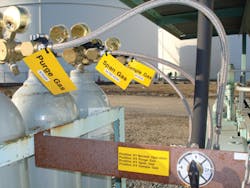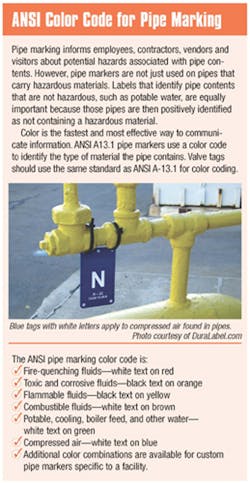Around the globe, the valve industry is rapidly developing. According to reports from Global Industry Analysts, the world industrial valve market will reach $72 billion in sales by 2012. The reasons for this growth include technological developments, new investments, and upgrading existing facilities in the water & sewerage and oil, gas & refining industries, as well as pharmaceutical and others.
Environmental legislation also plays into the market’s future performance. Currently, North America is the largest market in terms of consumption, while Asia leads in growth rate. With this growth, valve users continue to be challenged with properly identifying an increasing number of valves for repair, maintenance and validation requirements.
At refineries, for example, there may be hundreds of control valves and a few thousand manual valves in complex units and off-site configurations.
There are many types of valves that need ongoing repairs and maintenance, including solenoid, gate, plug, check, butterfly, pinch, diaphragm, ball, globe, etc. In some cases, identification is required on several parts of the valve—on the valve body, on the bottom of the valve, or underside.
"Most valves are encased in insulation," said Sean Croxford, Farris Engineering Services, Business Unit Manager. "So reading identification info on the valve is difficult. Also, it may be challenging to identify equipment in the field. Finally, valves are prone to rust—particularly in the Gulf Coast. Valve tags that are corrosion-resistant are preferred because you don’t want to make assumptions when gathering information in the field—particularly with pressure-relief devices."
Proper valve tag placement
Valve tag placement is not explicitly required by the American Society of Mechanical Engineers (ASME) or the American National Standards Institute (ANSI). What both organization’s codes require is the proper marking of a piping system. Valves are a part of a piping system, and the code is generally interpreted to mean that valves must also be properly labeled.
Valve tags should use the same standard as ANSI A-13.1 for color coding. The tag itself should identify the valve, usually by showing the valve number. The type of valve and the system the valve is part of typically are identified. For example, the valve tag might read "200# Main Steam Shut Off." This identifies the valve as the shutoff valve in the 200-pound main steam line. The type of valve is specified based on its function—not the design of the valve.
Other types of valves include control valves and relief valves. Type designations such as ball valves and gate valves describe the valve design and are typically not used on valve tags. Valve tags may also include functional information as a part of the valve name, such as "Machine 2A Condensate Sample Valve." Both sides of the tag may be used. Also, the backside of the valve tag is sometimes used for RTK ("Right-to-Know") labels, in systems carrying hazardous materials. Finally, the backside of the tag might include operating procedures.
"Conventional wastewater treatment plants have a lot of piping for differing functions in small spaces, along with valves where labeling becomes important and the consequences of opening a wrong valve are high," said Vivek Singh, Operations and Engineering Manager, Muskegon County Wastewater System, Michigan.
It’s advisable to place heavy-duty valve tags at locations where workers clearly see pipe contents before opening a valve. Valve tags issue safety messaging, provide operating instructions, display maintenance requirements, and much more. Heavy-duty valve tags give any 1/2-inch to 4-inch label supply a solid backing for marking. Sturdy construction means they’ll work well in locations where harsh, abrasive conditions prevail.
Valve tags should never be attached to the valve stem or to the actuator. If the small valve is mounted in a panel, a standard adhesive-backed label is applied to the panel. If the valve is freestanding, a separate surface may be added for attaching a label. Remember, it must be obvious that the information on the label or tag applies to the valve.
Brightly colored tags also help identify valves to match pipe and facility markings. Pre-drilled holes at corners, tops and bottoms make displaying valve tags easy. Tags can be simply attached to valves with plastic or metal ties. In some facilities, production departments either lasermark the valve bodies, laser-mark stainless steel tags, or hand write paper tags, depending on the customer”s requirements. There are several downsides to using hand-written paper tags, including legibility and durability.
"Depending upon how much information is required, tags provide the most room to mark information," said Brian Strait, of Check-All Valve Mfg. Co. "Especially on valves 2 inches and smaller where the body lacks enough room to inscribe or affix a tag," said Wes Barrett, of WB Valve Consultants LLC.
Valve labels prevent human error
In addition to being used for labeling valves, valve tags are also used to label other devices, such as actuators, transmitters and instruments. They can be used to label plants, identify containers, and label work in progress.
At the Los Angeles wastewater treatment site, according to Bahram Roshanian, Sanitation Wastewater Manager II, the following alphanumeric sequence is followed to identify valves:
A: Example: HSDW 1VA0201012
Minimum 13 characters that consist of: Plant designation (H = Hyperion), designation for the plant area (SDW = Sludge Dewatering), alpha numeric equipment train designation (1 = train #1), alpha numeric instrument or equipment type designation (VA02 = Plug Valve) and specific equipment number (01012).
Still, despite the best of intentions, errors do occur.
"In several places, I have seen many manual valves that are not labeled. As expected, this situation is one of the causes for human errors when setting the line-ups for transfers in the field," said Marc Valleur, senior consultant, Resources2energy. "We recently finished a gas plant valve audit for a client in Wyoming. The client hired us because the documentation from the engineering firm was not up to standards that would allow them to determine if the valves were good for NACE (formerly the National Association of Corrosion Engineers) service, and the construction firm did not install the valves in the proper location. There was a proper tag system put in place for all instruments and valves that identified the valve back to their designated valve coding system, which would direct you back to the piping specification. The affixed 300 Series Stainless Steel (SST) tagging system made our field walk-down effort much easier to identify and match the valve in the field with designator on the piping and instrumentation diagram/drawing (P&ID)," said Barrett.
As the demand for valves and proper valve identification continues to grow, manufacturers will continue to develop new and more durable valve identification tags.
At the time of this article’s publication, Jack Rubinger was an industrial copywriter for DuraLabel.com, a manufacturer of labeling systems and supplies including valve tags. Graphicproducts.com is a manufacturer of visual communication systems and supplies including valve tags. For application assistance, visit [email protected] or call 888-326-9244.




